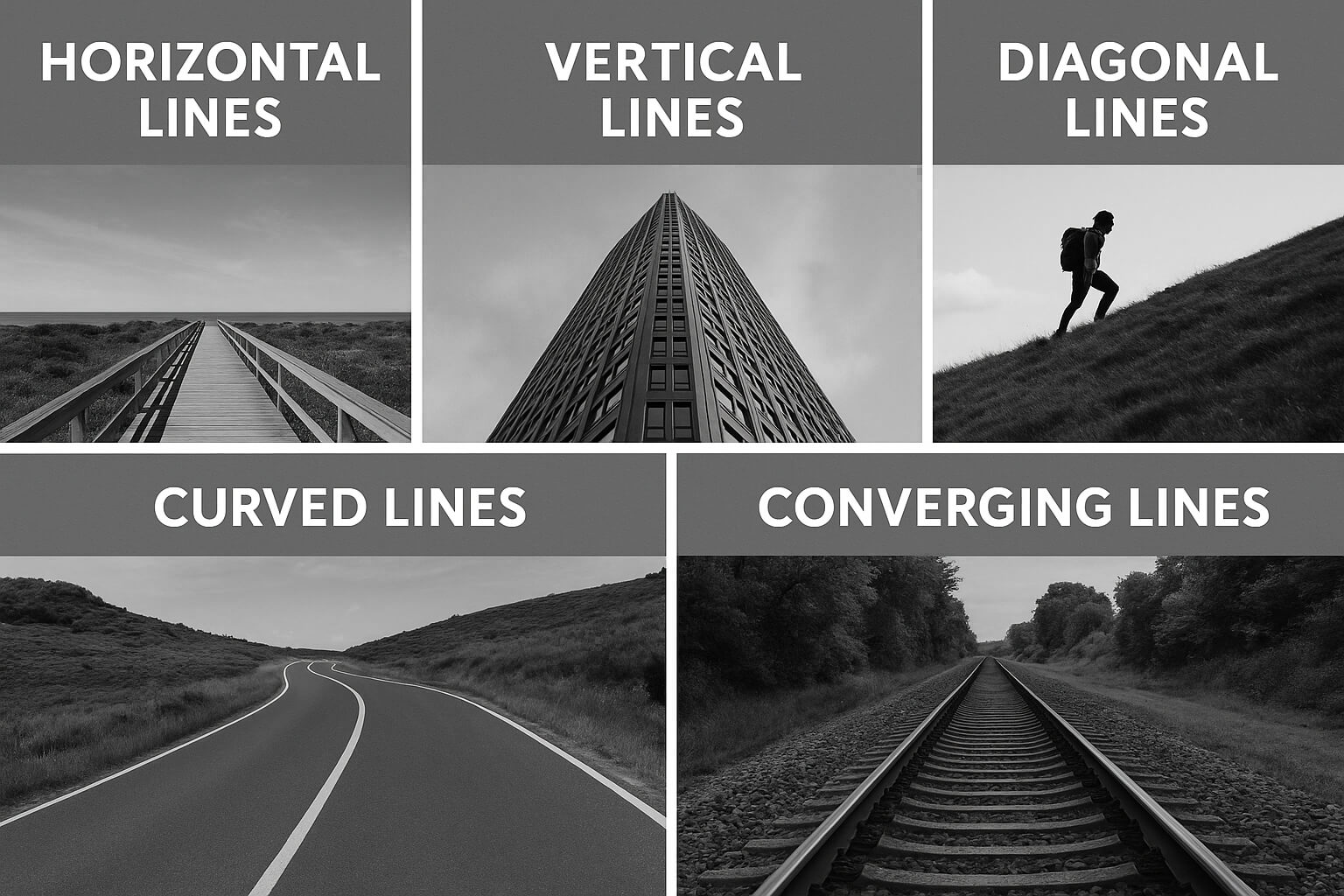In the world of visual storytelling, few composition techniques are as powerful — or as underrated — as leading lines. These invisible guides direct the viewer’s eye through a photo, creating movement, focus, and narrative in a single frame. Whether you’re photographing weddings, landscapes, portraits, or street scenes, learning how to master leading lines in photography composition can dramatically elevate your images.
In this article, we’ll explore the art and science of leading lines — drawing inspiration from expert-level photography themes like cinematic wedding photos, double exposures, black and white photography, and monetizing your shots.
What Are Leading Lines?
Leading lines are visual elements that guide the viewer’s gaze toward the main subject or deeper into the photo. These can be:
- Roads : Roads naturally lead the viewer’s eye from the foreground to the horizon or a focal point, symbolizing movement and direction. Ideal for landscapes and outdoor shots.
- Railways : Railway tracks create a converging path, guiding the viewer’s eye toward a vanishing point, often evoking a sense of journey, depth, and adventure.
- Fences : Fences, whether straight or with gaps, guide the viewer’s eye along their line, framing the scene and drawing attention to the main subject or deeper into the image.
- Rivers : A flowing river creates a natural curve or straight line that guides the viewer’s gaze, often leading to the horizon or a key focal point in nature photography.
- Shadows : Shadows cast by objects or light sources form dynamic leading lines that add depth, mystery, and drama, while guiding the viewer’s attention across the frame.
- Architecture : Architectural lines such as doorways, windows, and columns form structured, geometric lines that draw the viewer’s eye towards specific parts of the scene, creating balance and symmetry.
- Body Posture (Arms, Legs, Fingers, Gaze Direction) : A subject’s body—whether arms, legs, fingers, or gaze—can create implied lines that guide the viewer's attention toward the focal point or key area in portraiture and action shots.
They create a visual journey, pulling viewers into your story — a technique heavily used in cinematic wedding photography to evoke emotion and intimacy.
Why Leading Lines Matter
Leading lines aren't just aesthetic — they serve several key purposes:
- Draw focus to your subject
- Create depth in flat images
- Add movement to static scenes
- Balance composition
- Increase storytelling by controlling visual flow
Whether you're creating timeless black-and-white compositions or a dreamy double exposure, leading lines can dramatically impact how your viewer perceives the shot.
Types of Leading Lines

1. 📏 Horizontal Lines : Convey Calm, Stability, Serenity
- Description: Horizontal lines create a sense of balance and tranquility in an image. They often evoke feelings of peace, stability, and stillness because they mirror the natural horizon. The mind associates horizontal lines with the ground or water, creating a grounded, calm effect. They help in leading the viewer's eye across the image, typically from one side to the other, giving a sense of completeness.
- When to Use: Perfect for landscapes, seascapes, minimalistic scenes, or any photo where you want the viewer to feel calm or grounded. Horizontal lines are also great for wide-angle shots.
- Example Visual: Imagine a beach scene at sunset. The calm ocean line would guide the viewer’s gaze along the horizon, enhancing the peaceful vibe of the image.
2. ⬆ Vertical Lines : Express Strength, Growth, Power
- Description: Vertical lines represent authority, power, and strength. They can make an image feel towering, imposing, or dynamic. These lines often symbolize upward motion, like the growth of a tree or a tall building. They can also add height and depth to an image. Vertical lines draw the viewer's eye upward, which can evoke feelings of ambition, optimism, or even awe.
- When to Use: Ideal for architectural photography (like tall buildings, skyscrapers, or trees) or fashion photography, where the verticality of a person’s pose can be emphasized.
- Example Visual: Picture a shot of a skyscraper against the sky. The strong vertical lines of the building guide the eye upwards, reinforcing the feeling of power and dominance.
3. 🔺 Diagonal Lines : Add Energy and Motion
- Description: Diagonal lines create a sense of movement, action, and energy. They can guide the viewer’s eye through the frame in a way that feels dynamic and engaging. Diagonal lines break the monotony of horizontal or vertical lines by adding slanted directionality, leading the viewer's eye toward a focal point or guiding the eye across the frame. They evoke a sense of motion and urgency, giving a dynamic feel to the photograph.
- When to Use: Perfect for street photography, action shots, or any scenario where you want to convey movement, tension, or excitement. Diagonal lines also add depth and dimension to a scene.
- Example Visual: A bustling city street, with road lines, people walking, and cars driving diagonally across the frame, can create a sense of action and energy. The slanted lines give an impression of speed and forward motion.
4. 🔄 Curved Lines : Suggest Elegance, Movement, or Sensuality
- Description: Curved lines in photography often add a fluid, graceful, or soft quality to an image. They evoke a sense of natural beauty, elegance, and movement, making them especially useful in portraiture and fine art photography. Curved lines can also suggest intimacy and sensuality, which is why they are often used in bridal portraits or romantic settings.
- When to Use: Ideal for any shoot that emphasizes fluidity, like fine art, fashion, or portrait photography. Curved lines in landscapes (such as winding rivers or roads) can create a visually interesting flow, leading the viewer’s eye gently around the frame.
- Example Visual: In a bridal portrait, the curvature of a bride’s flowing gown and the shape of a curved staircase can guide the viewer’s eye, creating a soft, sensual feeling. The curve of a road or a river in a landscape can enhance the elegance of the scene.
5. ↘ Converging Lines : Lines that Meet at a Point, Drawing Intense Focus
- Description: Converging lines lead the viewer's eye toward a single point in the image. This technique creates a powerful sense of depth and perspective. By directing the focus to a central vanishing point, converging lines add a dramatic element to a composition, drawing intense attention to the subject at the center. These lines can heighten the importance of the focal point, making it feel more powerful and isolated.
- When to Use: Excellent for product photography, portrait photography, or any scenario where you want to eliminate distractions and bring attention to a specific subject. They are particularly effective when editing out background distractions like harsh shadows or clutter.
- Example Visual: In a portrait photo of a person standing at the center of a road or hallway, the lines of the road or walls converging towards the subject highlight them and draw the viewer’s attention straight to the person. This technique adds focus and emphasis on the subject.
How to Use Leading Lines Like a Pro
1. Start With a Clear Subject : Leading lines should always serve the story. Decide what you want the viewer to see first.
2. Change Your Perspective : Sometimes, you need to crouch low or shoot from above to align lines effectively — a trick often used by wedding photographers to add cinematic drama.
3. Combine With Lighting : Leading lines get even more powerful when paired with directional light — especially in black and white photos, where contrast makes the lines pop.
4. Use Natural & Man-Made Elements :
- A bride’s veil can form soft diagonal lines.
- A road can lead to a couple holding hands.
- A staircase can direct attention to a product.
This mirrors the creativity we admire in double exposure compositions, where visual layers add depth.
Best Tools & Editing Techniques
Once you've captured your shot, post-processing helps you enhance leading lines:
- Lightroom: Use the Crop Overlay Tool to check alignment.
- Photoshop: Use the Perspective Warp to fix or enhance converging lines.
- AI Tools like Luminar: Boost structure and contrast along your leading lines.
Want to sell your work? Mastering composition can help you stand out on top photography marketplaces like 500px, Adobe Stock, and Etsy.
Real-World Examples
Cinematic Wedding Photos : Use the aisle, floral arch, or train of the dress as leading lines to guide the eye to the bride and groom.
Travel Photography : Railway tracks, roads, or shorelines make stunning leading lines, drawing viewers into a journey.
Black and White : Architectural shadows can act as harsh, graphic lines, giving your monochrome image a modern edge.
Pro Tips for Beginners
- Use a wide-angle lens to exaggerate the effect.
- Practice shooting in cities, where lines are everywhere.
- Compose with the rule of thirds and lead toward one of the focal points.
- Always check your framing before hitting the shutter — minor adjustments create major impact.
Final Thoughts
Leading lines are more than a trick — they’re a storytelling device. Mastering them helps you control not just the look of your photo, but how someone feels as they experience it. Whether you’re creating moody bridal portraits, clean product shots, or dynamic travel images, use leading lines to guide the eye, evoke emotion, and elevate your work.
Once you’ve nailed this technique, your photos won’t just look better — they’ll communicate more clearly.

